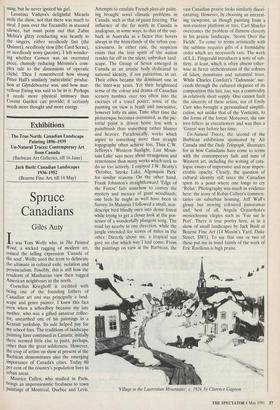Exhibitions
The True North: Canadian Landscape Painting 1896-1939 Un-Natural Traces: Contemporary Art from Canada (Barbican Art Galleries, till 16 June) Jack Bush: Canadian Landscapes 1936-1952 (Bourne Fine Art, till 14 May)
Spruce Canadians
Giles Auty
It was Tom Wolfe who, in The Painted Word, a wicked ragging of modern art, coined the telling expression 'Canada of the soul'. Wolfe used the term to delineate the ultimate in cultural exile, isolation and Provincialism. Possibly, this is still how the residents of Manhattan view their rugged American neighbours to the north.
Cornelius ICrieghoff is credited with being one of the founding fathers of Canadian art and was principally a land- scape and genre painter. I knew this fact even when a schoolboy because my late mother, who was a gifted amateur collec- tor, unearthed one of his paintings in a Kentish junkshop. Its sale helped pay for my school fees. The traditions of landscape Painting have continued in Canada; initially there seemed little else to paint, perhaps, other than the great wilderness. However, the crop of artists on show at present at the Barbican demonstrates also the emerging importance of Canada's cities. Today 80 Per cent of the country's population lives in urban areas.
Maurice Cullen, who studied in Paris, brings an impressionistic freshness to town Paintings of Montreal, Quebec and Levis.
Attempts to emulate French plein-air paint- ing brought novel climatic problems in Canada, such as that of paint freezing. The influence of the far north in Canada is analogous, in some ways, to that of the out- back in Australia as a factor that hovers always in the hinterlands of the urban con- sciousness. In either case, the suspicion exists that the true spirit of the nation resides far off in the silent, unbroken land- scape. The Group of Seven emerged in Canada as an artistic body dedicated to national identity, if not patriotism, in aft. Their ethos became the dominant one in the inter-war years. Yet their heightened sense of the colour and drama of Canadian scenery tumbles over too often into the excesses of a travel poster; some of the painting on view is brash and insensitive, however lofty its aims. Time after time the picturesque becomes overstated, as the pic- torial point is driven home less with a paintbrush than something rather blunter and heavier. Paradoxically, works which aspire to something more than straight topography often achieve less. Thus C.W. Jefferys's 'Western Sunlight, Last Moun- tain Lake' says more about strangeness and remoteness than many works which seek to do so too actively. I enjoyed J.W. Beatty's 'October, Smoke Lake, Algonquin Park' for similar reasons. On the other hand, Frank Johnston's straightforward 'Edge of the Forest' fails somehow to convey the mystery and menace of giant woodlands; one feels he might as well have been in Surrey. In Malaysia I followed a small, non- descript bird blindly once into dense forest while trying to get a closer look at the pos- sessor of a wonderfully plangent song. The road lay nearby in one direction, while the jungle extended for scores of miles in the other. Directly above me, a tropical sun gave no clue which way. I had come. From the paintings on view at the Barbican, the
vast Canadian prairie looks similarly disori- entating. However, by choosing an interest- ing viewpoint, as though painting from a non-existent platform or tree, Carl Shaefer overcomes the problem of flatness cleverly in his prairie landscape, 'Storm Over the Fields'. To come to terms artistically with the sublime requires gifts of a formidable order which are necessarily rare. The work of L.L. Fitzgerald introduces a note of sub- tlety, at least, which is often absent Other- wise in fierce orchestrations of the colours of lakes, mountains and autumnal trees. While Charles Comfort's `Tadoussac' suc- ceeds through the cultured elegance of its composition this last, too, was a commodity in relatively short supply. One cannot fault the sincerity of these artists, dor of Emily Cart who brought a personalised simplifi- cation, not unlike that of the Vorticists, to the forms of the forest. Moreover, she saw tree-fellers as executioners and was thus a 'Green' way before her time.
Un-Natural Traces, the second of the Barbican exhibitions sponsored by Air Canada and the Daily Telegraph, illustrates for us how Canadians have come to terms with the contemporary fads and isms of Western art, including the writing of cata- logue essays of impressive and near impen- etrable opacity. Clearly, the question of cultural identity still taxes the Canadian spirit to a point where one longs to cry 'Relax'. Photography was much in evidence here: the irony of Robin Collyer's commen- taries on suburban housing, Jeff Wall's glossy but moving coloured panoramas and, best of all, Angela Gratierholz's monochrome elegies such as 'Niue sur le Port'. There is true poetry here, as in a show of small landscapes by Jack Bush at Bourrie Fine Art (14 Mason's Yard, Duke Street, SW1). To say that one or two of these put me in mind faintly of the work of Eric Ravilious is high praise.
'Village in the Laurentian Mountains', c. 1924, by Clarence Gagnon


















































 Previous page
Previous page